Leadership and Management Report: Tesco's Strategies Analysis
VerifiedAdded on 2023/01/12
|17
|4892
|48
Report
AI Summary
This report provides a comprehensive analysis of leadership and management practices within Tesco, a British multinational grocery retailer. It begins with an introduction to the core concepts of management and leadership, emphasizing their roles in achieving organizational goals. The main body delves into management and leadership theories, including the trait theory of leadership, and explores the roles of leaders and managers within the organization. The report highlights the importance of effective decision-making, vision setting, and resource allocation. It also examines the similarities between leadership and management, emphasizing the common goal of achieving organizational objectives. Furthermore, the report discusses leadership development programs and concludes with a summary of the key findings and references used. The report also mentions the NHS program and its benefits to the company.
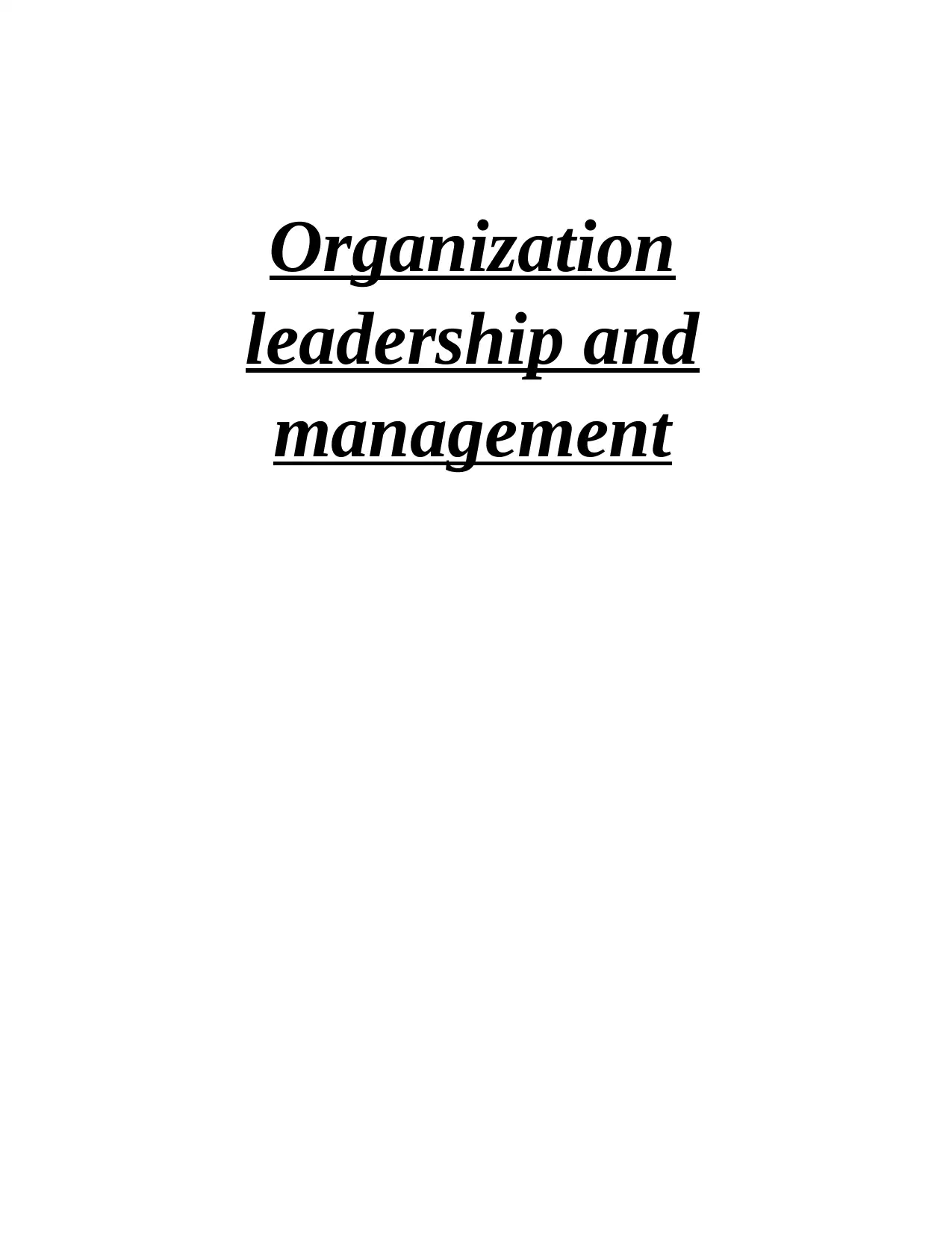
Organization
leadership and
management
leadership and
management
Paraphrase This Document
Need a fresh take? Get an instant paraphrase of this document with our AI Paraphraser
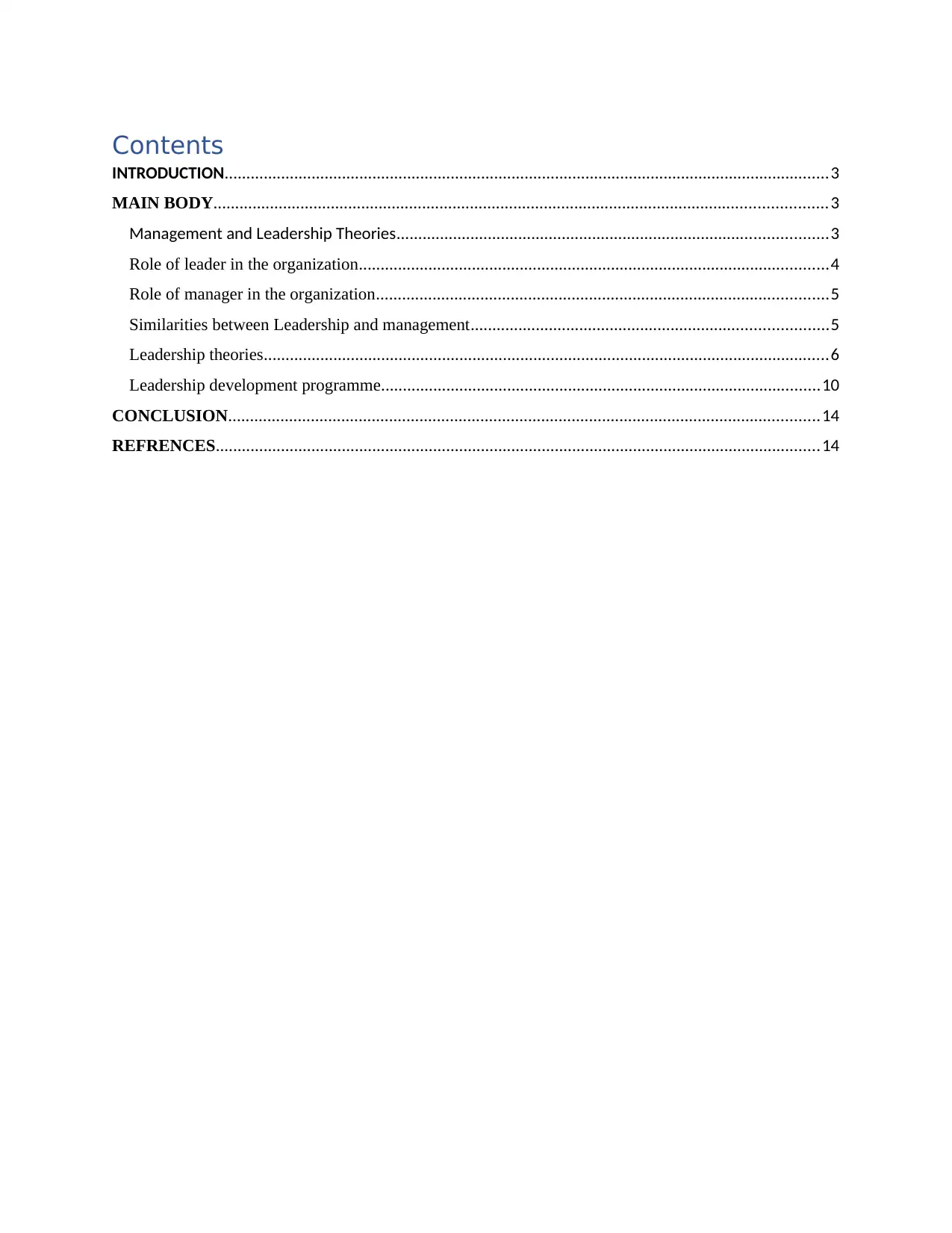
Contents
INTRODUCTION...........................................................................................................................................3
MAIN BODY.............................................................................................................................................3
Management and Leadership Theories...................................................................................................3
Role of leader in the organization............................................................................................................4
Role of manager in the organization........................................................................................................5
Similarities between Leadership and management..................................................................................5
Leadership theories..................................................................................................................................6
Leadership development programme.....................................................................................................10
CONCLUSION........................................................................................................................................14
REFRENCES...........................................................................................................................................14
INTRODUCTION...........................................................................................................................................3
MAIN BODY.............................................................................................................................................3
Management and Leadership Theories...................................................................................................3
Role of leader in the organization............................................................................................................4
Role of manager in the organization........................................................................................................5
Similarities between Leadership and management..................................................................................5
Leadership theories..................................................................................................................................6
Leadership development programme.....................................................................................................10
CONCLUSION........................................................................................................................................14
REFRENCES...........................................................................................................................................14
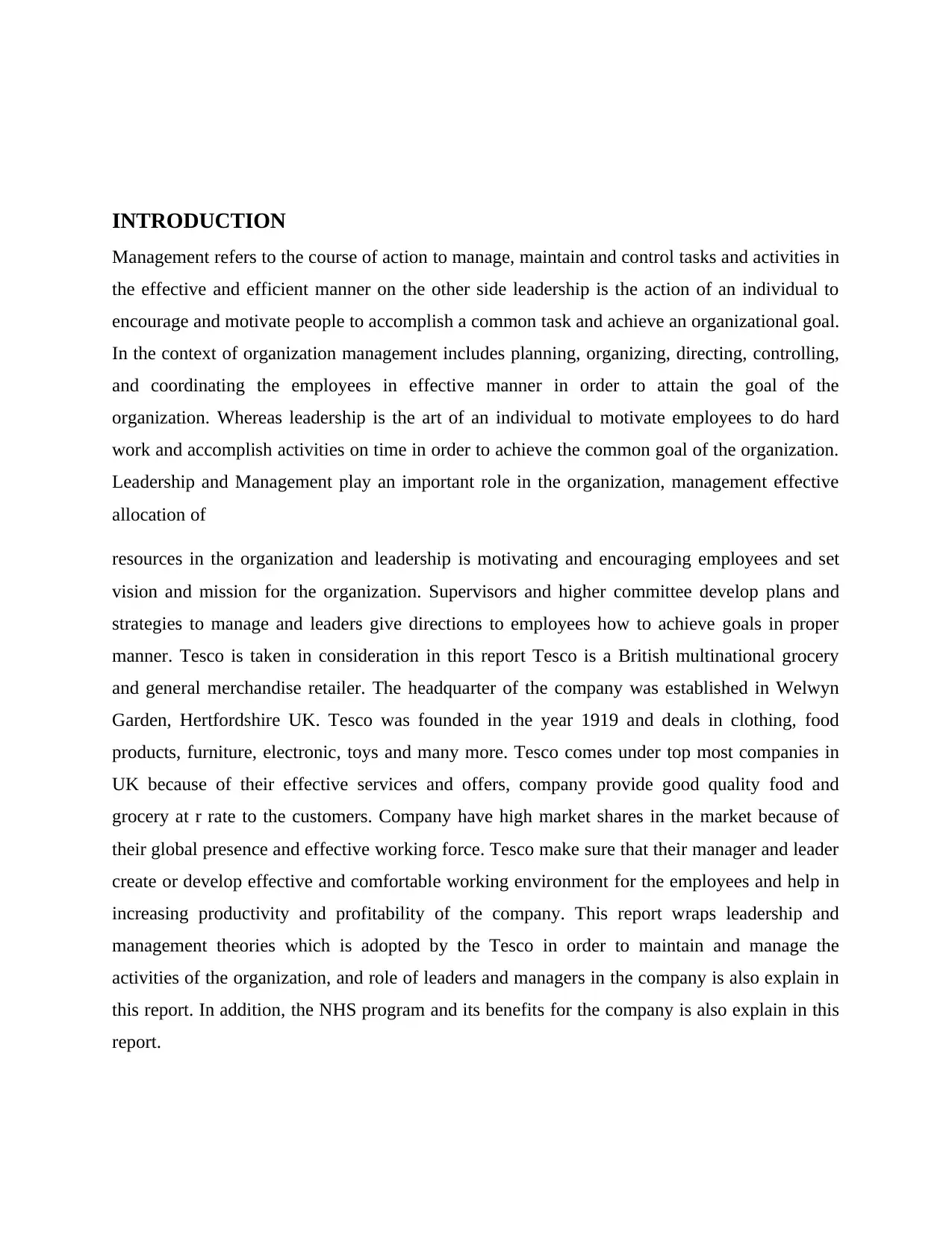
INTRODUCTION
Management refers to the course of action to manage, maintain and control tasks and activities in
the effective and efficient manner on the other side leadership is the action of an individual to
encourage and motivate people to accomplish a common task and achieve an organizational goal.
In the context of organization management includes planning, organizing, directing, controlling,
and coordinating the employees in effective manner in order to attain the goal of the
organization. Whereas leadership is the art of an individual to motivate employees to do hard
work and accomplish activities on time in order to achieve the common goal of the organization.
Leadership and Management play an important role in the organization, management effective
allocation of
resources in the organization and leadership is motivating and encouraging employees and set
vision and mission for the organization. Supervisors and higher committee develop plans and
strategies to manage and leaders give directions to employees how to achieve goals in proper
manner. Tesco is taken in consideration in this report Tesco is a British multinational grocery
and general merchandise retailer. The headquarter of the company was established in Welwyn
Garden, Hertfordshire UK. Tesco was founded in the year 1919 and deals in clothing, food
products, furniture, electronic, toys and many more. Tesco comes under top most companies in
UK because of their effective services and offers, company provide good quality food and
grocery at r rate to the customers. Company have high market shares in the market because of
their global presence and effective working force. Tesco make sure that their manager and leader
create or develop effective and comfortable working environment for the employees and help in
increasing productivity and profitability of the company. This report wraps leadership and
management theories which is adopted by the Tesco in order to maintain and manage the
activities of the organization, and role of leaders and managers in the company is also explain in
this report. In addition, the NHS program and its benefits for the company is also explain in this
report.
Management refers to the course of action to manage, maintain and control tasks and activities in
the effective and efficient manner on the other side leadership is the action of an individual to
encourage and motivate people to accomplish a common task and achieve an organizational goal.
In the context of organization management includes planning, organizing, directing, controlling,
and coordinating the employees in effective manner in order to attain the goal of the
organization. Whereas leadership is the art of an individual to motivate employees to do hard
work and accomplish activities on time in order to achieve the common goal of the organization.
Leadership and Management play an important role in the organization, management effective
allocation of
resources in the organization and leadership is motivating and encouraging employees and set
vision and mission for the organization. Supervisors and higher committee develop plans and
strategies to manage and leaders give directions to employees how to achieve goals in proper
manner. Tesco is taken in consideration in this report Tesco is a British multinational grocery
and general merchandise retailer. The headquarter of the company was established in Welwyn
Garden, Hertfordshire UK. Tesco was founded in the year 1919 and deals in clothing, food
products, furniture, electronic, toys and many more. Tesco comes under top most companies in
UK because of their effective services and offers, company provide good quality food and
grocery at r rate to the customers. Company have high market shares in the market because of
their global presence and effective working force. Tesco make sure that their manager and leader
create or develop effective and comfortable working environment for the employees and help in
increasing productivity and profitability of the company. This report wraps leadership and
management theories which is adopted by the Tesco in order to maintain and manage the
activities of the organization, and role of leaders and managers in the company is also explain in
this report. In addition, the NHS program and its benefits for the company is also explain in this
report.
⊘ This is a preview!⊘
Do you want full access?
Subscribe today to unlock all pages.

Trusted by 1+ million students worldwide
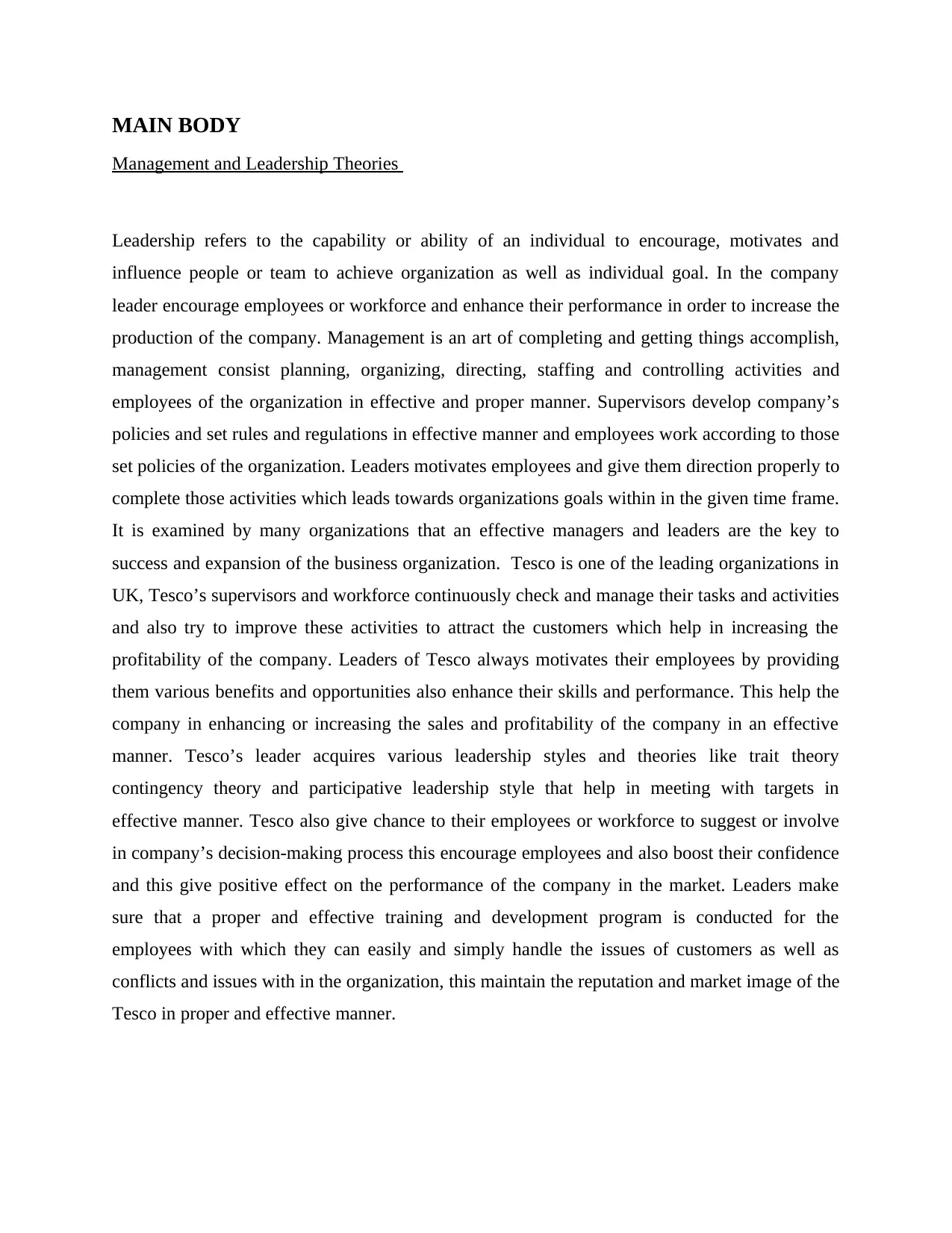
MAIN BODY
Management and Leadership Theories
Leadership refers to the capability or ability of an individual to encourage, motivates and
influence people or team to achieve organization as well as individual goal. In the company
leader encourage employees or workforce and enhance their performance in order to increase the
production of the company. Management is an art of completing and getting things accomplish,
management consist planning, organizing, directing, staffing and controlling activities and
employees of the organization in effective and proper manner. Supervisors develop company’s
policies and set rules and regulations in effective manner and employees work according to those
set policies of the organization. Leaders motivates employees and give them direction properly to
complete those activities which leads towards organizations goals within in the given time frame.
It is examined by many organizations that an effective managers and leaders are the key to
success and expansion of the business organization. Tesco is one of the leading organizations in
UK, Tesco’s supervisors and workforce continuously check and manage their tasks and activities
and also try to improve these activities to attract the customers which help in increasing the
profitability of the company. Leaders of Tesco always motivates their employees by providing
them various benefits and opportunities also enhance their skills and performance. This help the
company in enhancing or increasing the sales and profitability of the company in an effective
manner. Tesco’s leader acquires various leadership styles and theories like trait theory
contingency theory and participative leadership style that help in meeting with targets in
effective manner. Tesco also give chance to their employees or workforce to suggest or involve
in company’s decision-making process this encourage employees and also boost their confidence
and this give positive effect on the performance of the company in the market. Leaders make
sure that a proper and effective training and development program is conducted for the
employees with which they can easily and simply handle the issues of customers as well as
conflicts and issues with in the organization, this maintain the reputation and market image of the
Tesco in proper and effective manner.
Management and Leadership Theories
Leadership refers to the capability or ability of an individual to encourage, motivates and
influence people or team to achieve organization as well as individual goal. In the company
leader encourage employees or workforce and enhance their performance in order to increase the
production of the company. Management is an art of completing and getting things accomplish,
management consist planning, organizing, directing, staffing and controlling activities and
employees of the organization in effective and proper manner. Supervisors develop company’s
policies and set rules and regulations in effective manner and employees work according to those
set policies of the organization. Leaders motivates employees and give them direction properly to
complete those activities which leads towards organizations goals within in the given time frame.
It is examined by many organizations that an effective managers and leaders are the key to
success and expansion of the business organization. Tesco is one of the leading organizations in
UK, Tesco’s supervisors and workforce continuously check and manage their tasks and activities
and also try to improve these activities to attract the customers which help in increasing the
profitability of the company. Leaders of Tesco always motivates their employees by providing
them various benefits and opportunities also enhance their skills and performance. This help the
company in enhancing or increasing the sales and profitability of the company in an effective
manner. Tesco’s leader acquires various leadership styles and theories like trait theory
contingency theory and participative leadership style that help in meeting with targets in
effective manner. Tesco also give chance to their employees or workforce to suggest or involve
in company’s decision-making process this encourage employees and also boost their confidence
and this give positive effect on the performance of the company in the market. Leaders make
sure that a proper and effective training and development program is conducted for the
employees with which they can easily and simply handle the issues of customers as well as
conflicts and issues with in the organization, this maintain the reputation and market image of the
Tesco in proper and effective manner.
Paraphrase This Document
Need a fresh take? Get an instant paraphrase of this document with our AI Paraphraser
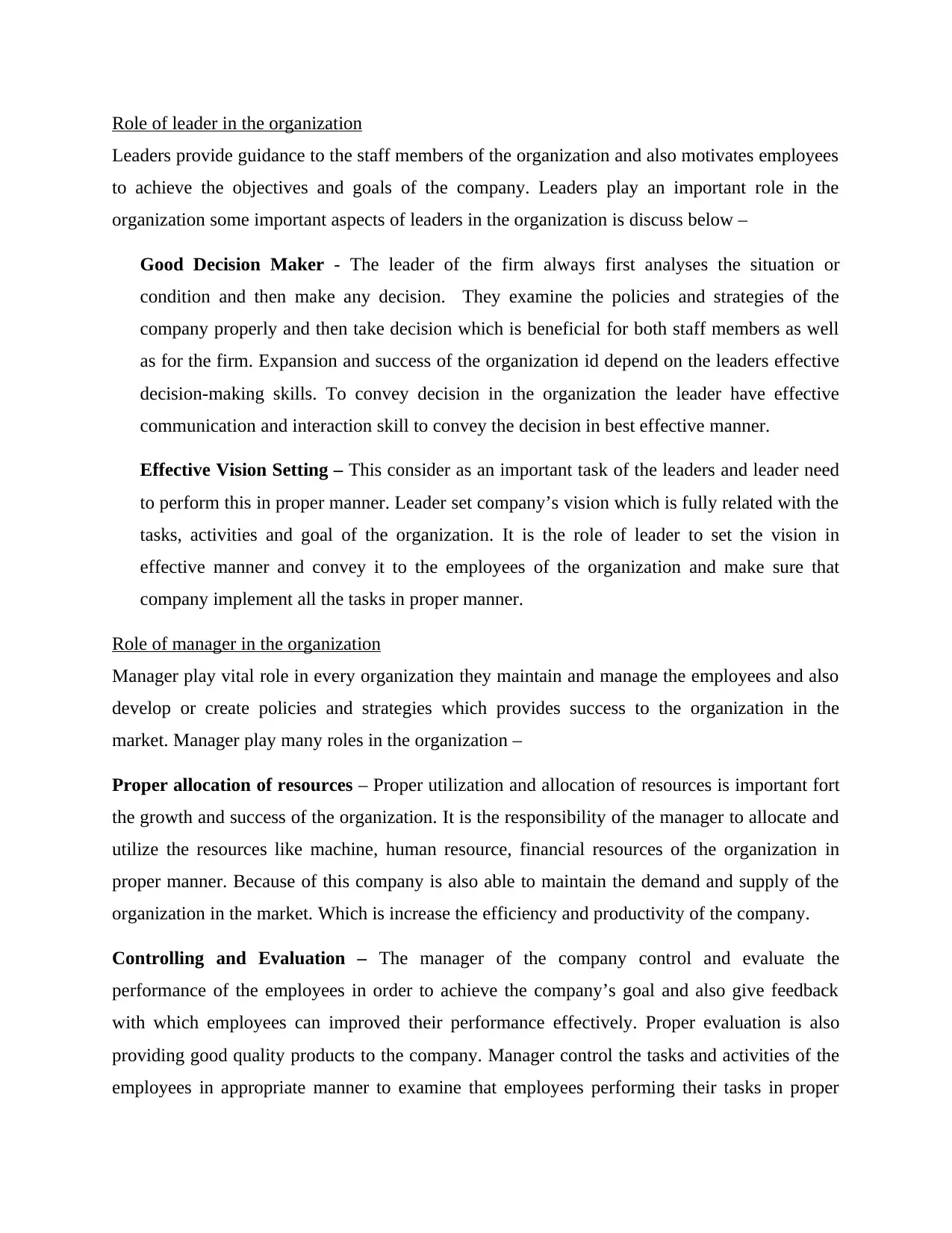
Role of leader in the organization
Leaders provide guidance to the staff members of the organization and also motivates employees
to achieve the objectives and goals of the company. Leaders play an important role in the
organization some important aspects of leaders in the organization is discuss below –
Good Decision Maker - The leader of the firm always first analyses the situation or
condition and then make any decision. They examine the policies and strategies of the
company properly and then take decision which is beneficial for both staff members as well
as for the firm. Expansion and success of the organization id depend on the leaders effective
decision-making skills. To convey decision in the organization the leader have effective
communication and interaction skill to convey the decision in best effective manner.
Effective Vision Setting – This consider as an important task of the leaders and leader need
to perform this in proper manner. Leader set company’s vision which is fully related with the
tasks, activities and goal of the organization. It is the role of leader to set the vision in
effective manner and convey it to the employees of the organization and make sure that
company implement all the tasks in proper manner.
Role of manager in the organization
Manager play vital role in every organization they maintain and manage the employees and also
develop or create policies and strategies which provides success to the organization in the
market. Manager play many roles in the organization –
Proper allocation of resources – Proper utilization and allocation of resources is important fort
the growth and success of the organization. It is the responsibility of the manager to allocate and
utilize the resources like machine, human resource, financial resources of the organization in
proper manner. Because of this company is also able to maintain the demand and supply of the
organization in the market. Which is increase the efficiency and productivity of the company.
Controlling and Evaluation – The manager of the company control and evaluate the
performance of the employees in order to achieve the company’s goal and also give feedback
with which employees can improved their performance effectively. Proper evaluation is also
providing good quality products to the company. Manager control the tasks and activities of the
employees in appropriate manner to examine that employees performing their tasks in proper
Leaders provide guidance to the staff members of the organization and also motivates employees
to achieve the objectives and goals of the company. Leaders play an important role in the
organization some important aspects of leaders in the organization is discuss below –
Good Decision Maker - The leader of the firm always first analyses the situation or
condition and then make any decision. They examine the policies and strategies of the
company properly and then take decision which is beneficial for both staff members as well
as for the firm. Expansion and success of the organization id depend on the leaders effective
decision-making skills. To convey decision in the organization the leader have effective
communication and interaction skill to convey the decision in best effective manner.
Effective Vision Setting – This consider as an important task of the leaders and leader need
to perform this in proper manner. Leader set company’s vision which is fully related with the
tasks, activities and goal of the organization. It is the role of leader to set the vision in
effective manner and convey it to the employees of the organization and make sure that
company implement all the tasks in proper manner.
Role of manager in the organization
Manager play vital role in every organization they maintain and manage the employees and also
develop or create policies and strategies which provides success to the organization in the
market. Manager play many roles in the organization –
Proper allocation of resources – Proper utilization and allocation of resources is important fort
the growth and success of the organization. It is the responsibility of the manager to allocate and
utilize the resources like machine, human resource, financial resources of the organization in
proper manner. Because of this company is also able to maintain the demand and supply of the
organization in the market. Which is increase the efficiency and productivity of the company.
Controlling and Evaluation – The manager of the company control and evaluate the
performance of the employees in order to achieve the company’s goal and also give feedback
with which employees can improved their performance effectively. Proper evaluation is also
providing good quality products to the company. Manager control the tasks and activities of the
employees in appropriate manner to examine that employees performing their tasks in proper
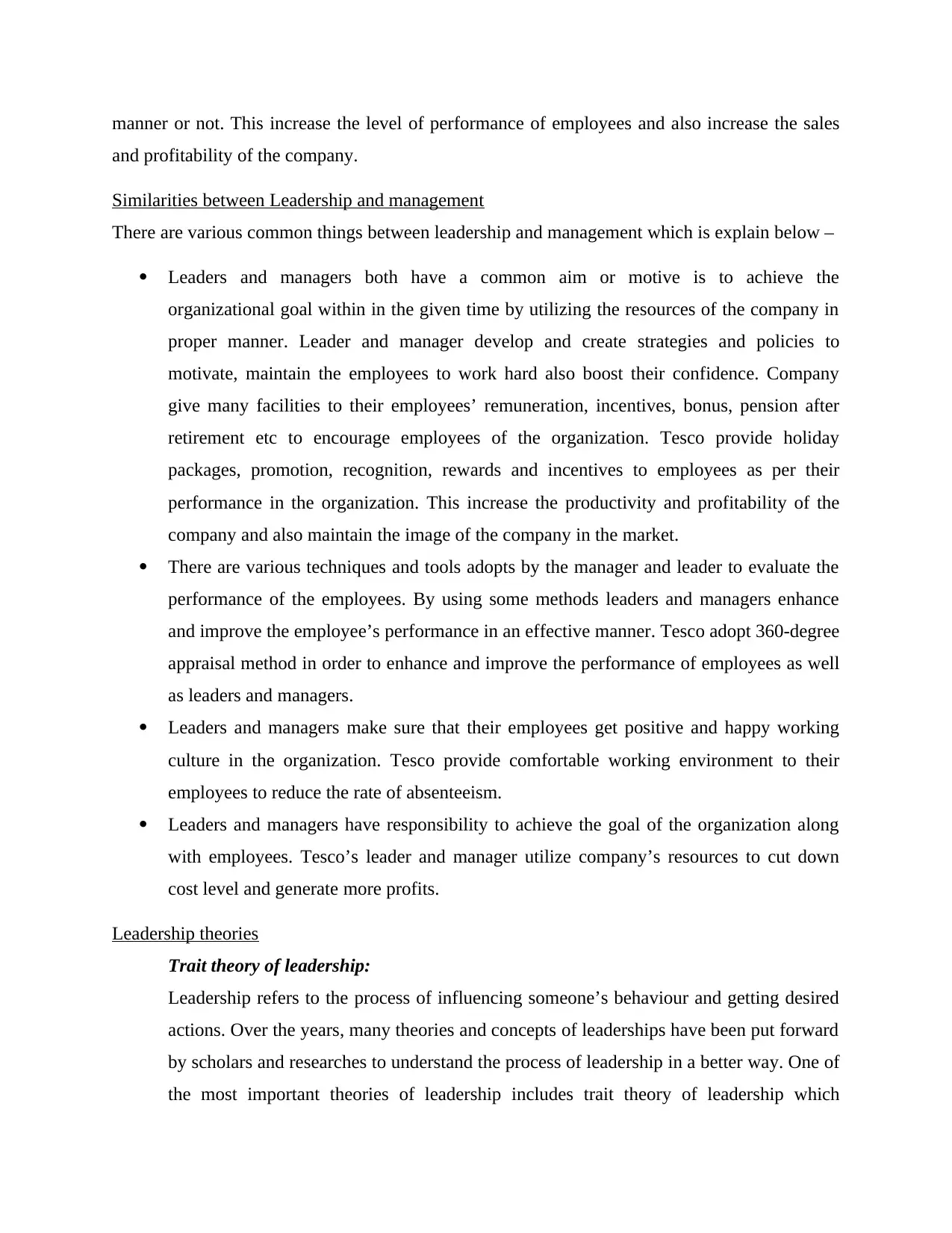
manner or not. This increase the level of performance of employees and also increase the sales
and profitability of the company.
Similarities between Leadership and management
There are various common things between leadership and management which is explain below –
Leaders and managers both have a common aim or motive is to achieve the
organizational goal within in the given time by utilizing the resources of the company in
proper manner. Leader and manager develop and create strategies and policies to
motivate, maintain the employees to work hard also boost their confidence. Company
give many facilities to their employees’ remuneration, incentives, bonus, pension after
retirement etc to encourage employees of the organization. Tesco provide holiday
packages, promotion, recognition, rewards and incentives to employees as per their
performance in the organization. This increase the productivity and profitability of the
company and also maintain the image of the company in the market.
There are various techniques and tools adopts by the manager and leader to evaluate the
performance of the employees. By using some methods leaders and managers enhance
and improve the employee’s performance in an effective manner. Tesco adopt 360-degree
appraisal method in order to enhance and improve the performance of employees as well
as leaders and managers.
Leaders and managers make sure that their employees get positive and happy working
culture in the organization. Tesco provide comfortable working environment to their
employees to reduce the rate of absenteeism.
Leaders and managers have responsibility to achieve the goal of the organization along
with employees. Tesco’s leader and manager utilize company’s resources to cut down
cost level and generate more profits.
Leadership theories
Trait theory of leadership:
Leadership refers to the process of influencing someone’s behaviour and getting desired
actions. Over the years, many theories and concepts of leaderships have been put forward
by scholars and researches to understand the process of leadership in a better way. One of
the most important theories of leadership includes trait theory of leadership which
and profitability of the company.
Similarities between Leadership and management
There are various common things between leadership and management which is explain below –
Leaders and managers both have a common aim or motive is to achieve the
organizational goal within in the given time by utilizing the resources of the company in
proper manner. Leader and manager develop and create strategies and policies to
motivate, maintain the employees to work hard also boost their confidence. Company
give many facilities to their employees’ remuneration, incentives, bonus, pension after
retirement etc to encourage employees of the organization. Tesco provide holiday
packages, promotion, recognition, rewards and incentives to employees as per their
performance in the organization. This increase the productivity and profitability of the
company and also maintain the image of the company in the market.
There are various techniques and tools adopts by the manager and leader to evaluate the
performance of the employees. By using some methods leaders and managers enhance
and improve the employee’s performance in an effective manner. Tesco adopt 360-degree
appraisal method in order to enhance and improve the performance of employees as well
as leaders and managers.
Leaders and managers make sure that their employees get positive and happy working
culture in the organization. Tesco provide comfortable working environment to their
employees to reduce the rate of absenteeism.
Leaders and managers have responsibility to achieve the goal of the organization along
with employees. Tesco’s leader and manager utilize company’s resources to cut down
cost level and generate more profits.
Leadership theories
Trait theory of leadership:
Leadership refers to the process of influencing someone’s behaviour and getting desired
actions. Over the years, many theories and concepts of leaderships have been put forward
by scholars and researches to understand the process of leadership in a better way. One of
the most important theories of leadership includes trait theory of leadership which
⊘ This is a preview!⊘
Do you want full access?
Subscribe today to unlock all pages.

Trusted by 1+ million students worldwide
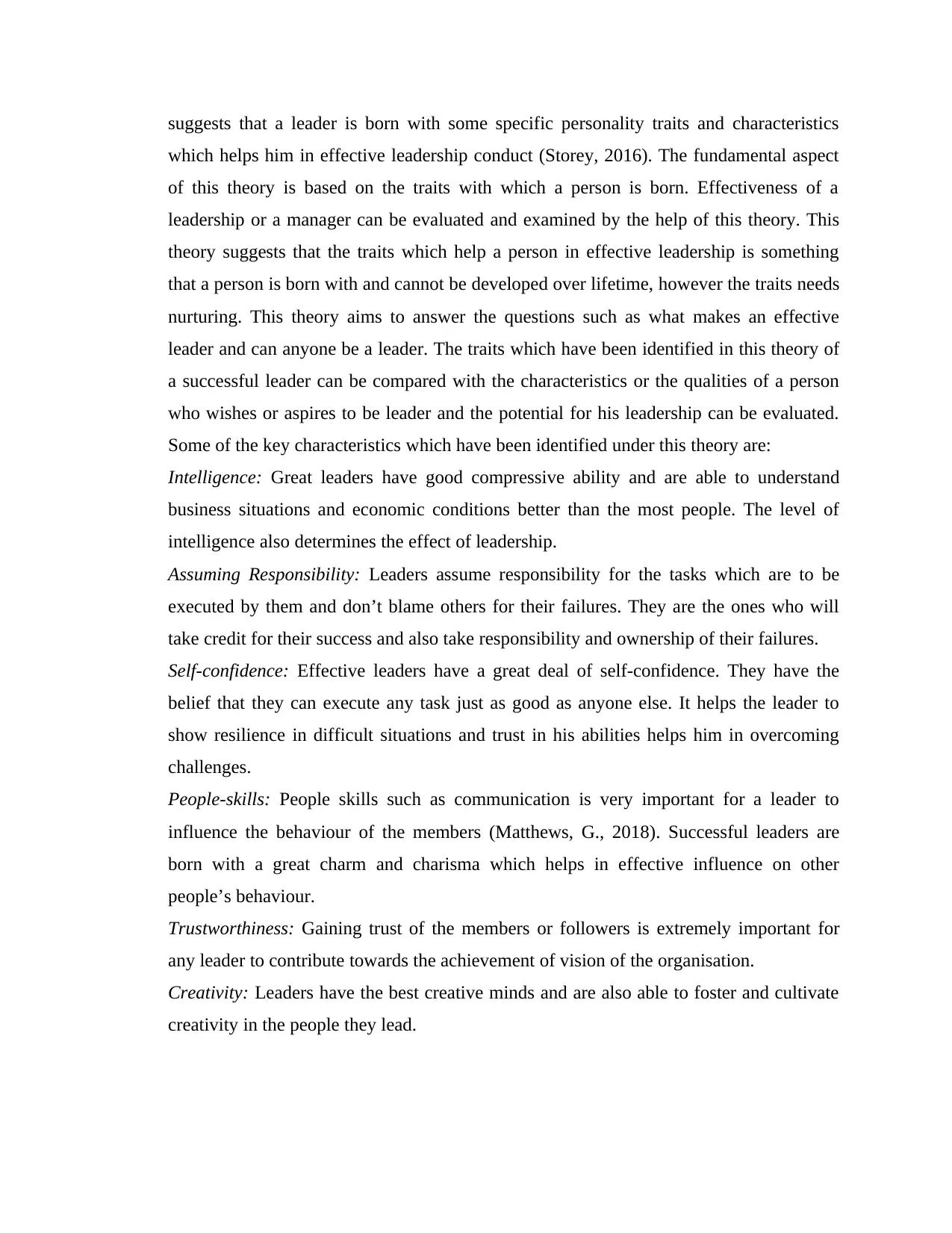
suggests that a leader is born with some specific personality traits and characteristics
which helps him in effective leadership conduct (Storey, 2016). The fundamental aspect
of this theory is based on the traits with which a person is born. Effectiveness of a
leadership or a manager can be evaluated and examined by the help of this theory. This
theory suggests that the traits which help a person in effective leadership is something
that a person is born with and cannot be developed over lifetime, however the traits needs
nurturing. This theory aims to answer the questions such as what makes an effective
leader and can anyone be a leader. The traits which have been identified in this theory of
a successful leader can be compared with the characteristics or the qualities of a person
who wishes or aspires to be leader and the potential for his leadership can be evaluated.
Some of the key characteristics which have been identified under this theory are:
Intelligence: Great leaders have good compressive ability and are able to understand
business situations and economic conditions better than the most people. The level of
intelligence also determines the effect of leadership.
Assuming Responsibility: Leaders assume responsibility for the tasks which are to be
executed by them and don’t blame others for their failures. They are the ones who will
take credit for their success and also take responsibility and ownership of their failures.
Self-confidence: Effective leaders have a great deal of self-confidence. They have the
belief that they can execute any task just as good as anyone else. It helps the leader to
show resilience in difficult situations and trust in his abilities helps him in overcoming
challenges.
People-skills: People skills such as communication is very important for a leader to
influence the behaviour of the members (Matthews, G., 2018). Successful leaders are
born with a great charm and charisma which helps in effective influence on other
people’s behaviour.
Trustworthiness: Gaining trust of the members or followers is extremely important for
any leader to contribute towards the achievement of vision of the organisation.
Creativity: Leaders have the best creative minds and are also able to foster and cultivate
creativity in the people they lead.
which helps him in effective leadership conduct (Storey, 2016). The fundamental aspect
of this theory is based on the traits with which a person is born. Effectiveness of a
leadership or a manager can be evaluated and examined by the help of this theory. This
theory suggests that the traits which help a person in effective leadership is something
that a person is born with and cannot be developed over lifetime, however the traits needs
nurturing. This theory aims to answer the questions such as what makes an effective
leader and can anyone be a leader. The traits which have been identified in this theory of
a successful leader can be compared with the characteristics or the qualities of a person
who wishes or aspires to be leader and the potential for his leadership can be evaluated.
Some of the key characteristics which have been identified under this theory are:
Intelligence: Great leaders have good compressive ability and are able to understand
business situations and economic conditions better than the most people. The level of
intelligence also determines the effect of leadership.
Assuming Responsibility: Leaders assume responsibility for the tasks which are to be
executed by them and don’t blame others for their failures. They are the ones who will
take credit for their success and also take responsibility and ownership of their failures.
Self-confidence: Effective leaders have a great deal of self-confidence. They have the
belief that they can execute any task just as good as anyone else. It helps the leader to
show resilience in difficult situations and trust in his abilities helps him in overcoming
challenges.
People-skills: People skills such as communication is very important for a leader to
influence the behaviour of the members (Matthews, G., 2018). Successful leaders are
born with a great charm and charisma which helps in effective influence on other
people’s behaviour.
Trustworthiness: Gaining trust of the members or followers is extremely important for
any leader to contribute towards the achievement of vision of the organisation.
Creativity: Leaders have the best creative minds and are also able to foster and cultivate
creativity in the people they lead.
Paraphrase This Document
Need a fresh take? Get an instant paraphrase of this document with our AI Paraphraser
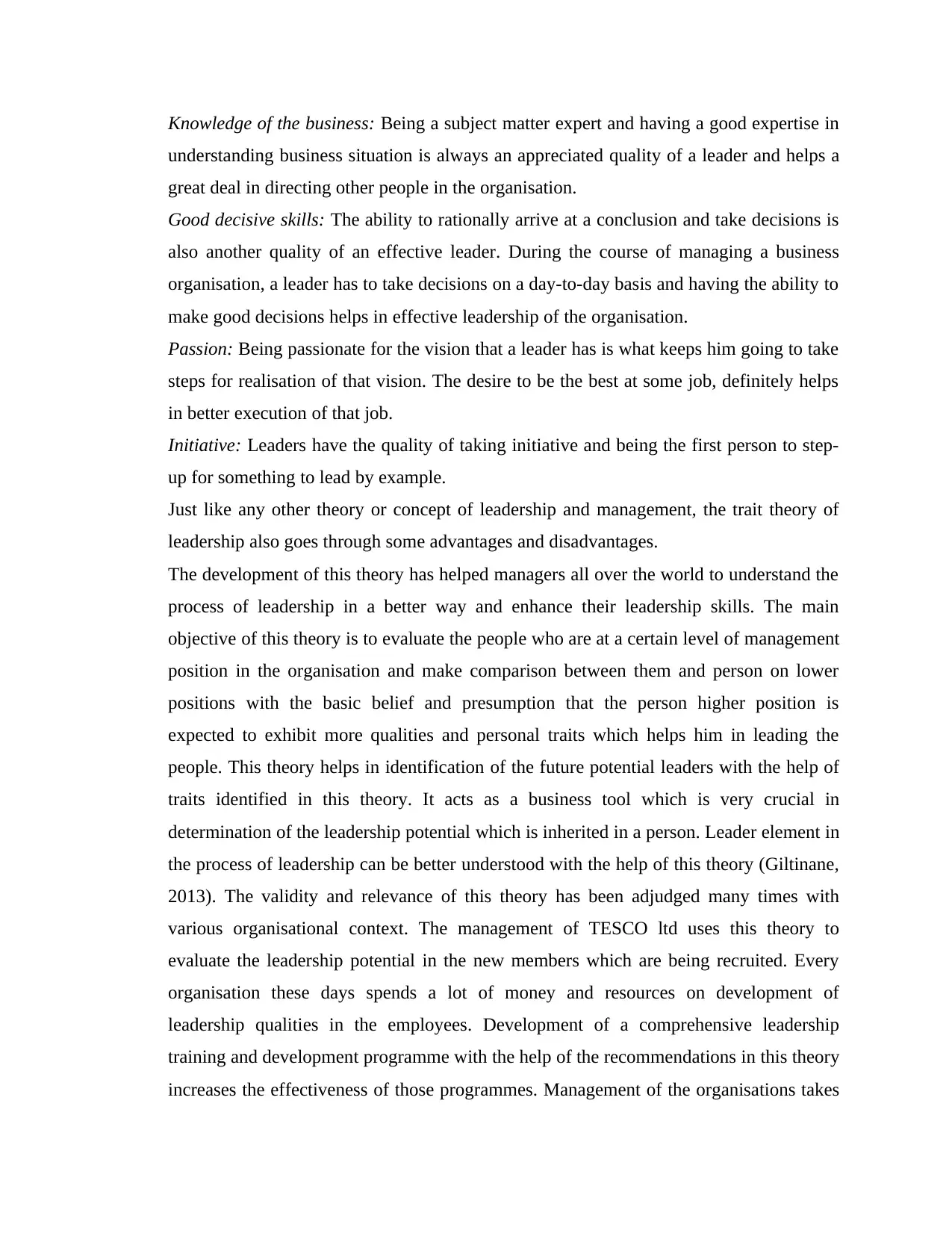
Knowledge of the business: Being a subject matter expert and having a good expertise in
understanding business situation is always an appreciated quality of a leader and helps a
great deal in directing other people in the organisation.
Good decisive skills: The ability to rationally arrive at a conclusion and take decisions is
also another quality of an effective leader. During the course of managing a business
organisation, a leader has to take decisions on a day-to-day basis and having the ability to
make good decisions helps in effective leadership of the organisation.
Passion: Being passionate for the vision that a leader has is what keeps him going to take
steps for realisation of that vision. The desire to be the best at some job, definitely helps
in better execution of that job.
Initiative: Leaders have the quality of taking initiative and being the first person to step-
up for something to lead by example.
Just like any other theory or concept of leadership and management, the trait theory of
leadership also goes through some advantages and disadvantages.
The development of this theory has helped managers all over the world to understand the
process of leadership in a better way and enhance their leadership skills. The main
objective of this theory is to evaluate the people who are at a certain level of management
position in the organisation and make comparison between them and person on lower
positions with the basic belief and presumption that the person higher position is
expected to exhibit more qualities and personal traits which helps him in leading the
people. This theory helps in identification of the future potential leaders with the help of
traits identified in this theory. It acts as a business tool which is very crucial in
determination of the leadership potential which is inherited in a person. Leader element in
the process of leadership can be better understood with the help of this theory (Giltinane,
2013). The validity and relevance of this theory has been adjudged many times with
various organisational context. The management of TESCO ltd uses this theory to
evaluate the leadership potential in the new members which are being recruited. Every
organisation these days spends a lot of money and resources on development of
leadership qualities in the employees. Development of a comprehensive leadership
training and development programme with the help of the recommendations in this theory
increases the effectiveness of those programmes. Management of the organisations takes
understanding business situation is always an appreciated quality of a leader and helps a
great deal in directing other people in the organisation.
Good decisive skills: The ability to rationally arrive at a conclusion and take decisions is
also another quality of an effective leader. During the course of managing a business
organisation, a leader has to take decisions on a day-to-day basis and having the ability to
make good decisions helps in effective leadership of the organisation.
Passion: Being passionate for the vision that a leader has is what keeps him going to take
steps for realisation of that vision. The desire to be the best at some job, definitely helps
in better execution of that job.
Initiative: Leaders have the quality of taking initiative and being the first person to step-
up for something to lead by example.
Just like any other theory or concept of leadership and management, the trait theory of
leadership also goes through some advantages and disadvantages.
The development of this theory has helped managers all over the world to understand the
process of leadership in a better way and enhance their leadership skills. The main
objective of this theory is to evaluate the people who are at a certain level of management
position in the organisation and make comparison between them and person on lower
positions with the basic belief and presumption that the person higher position is
expected to exhibit more qualities and personal traits which helps him in leading the
people. This theory helps in identification of the future potential leaders with the help of
traits identified in this theory. It acts as a business tool which is very crucial in
determination of the leadership potential which is inherited in a person. Leader element in
the process of leadership can be better understood with the help of this theory (Giltinane,
2013). The validity and relevance of this theory has been adjudged many times with
various organisational context. The management of TESCO ltd uses this theory to
evaluate the leadership potential in the new members which are being recruited. Every
organisation these days spends a lot of money and resources on development of
leadership qualities in the employees. Development of a comprehensive leadership
training and development programme with the help of the recommendations in this theory
increases the effectiveness of those programmes. Management of the organisations takes
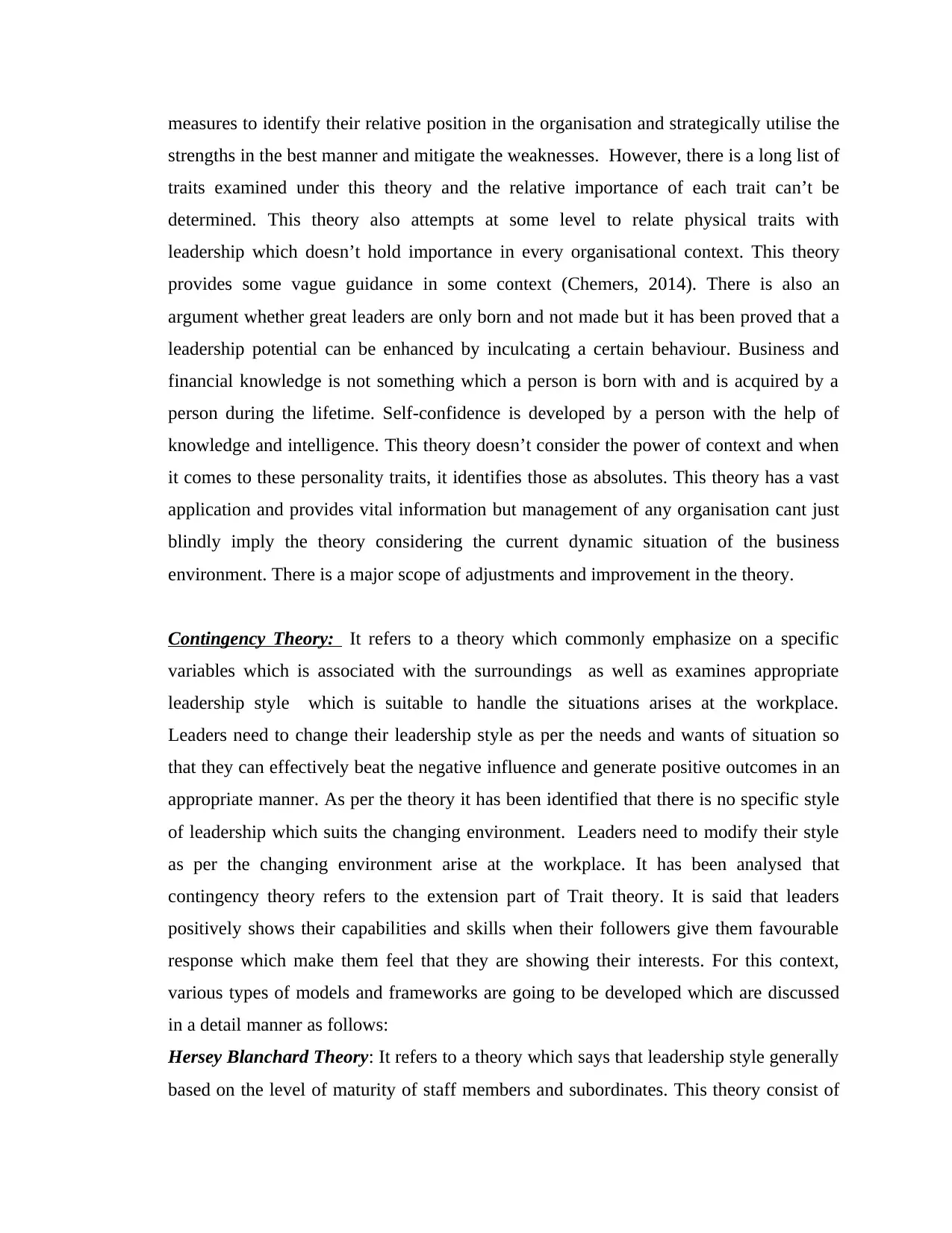
measures to identify their relative position in the organisation and strategically utilise the
strengths in the best manner and mitigate the weaknesses. However, there is a long list of
traits examined under this theory and the relative importance of each trait can’t be
determined. This theory also attempts at some level to relate physical traits with
leadership which doesn’t hold importance in every organisational context. This theory
provides some vague guidance in some context (Chemers, 2014). There is also an
argument whether great leaders are only born and not made but it has been proved that a
leadership potential can be enhanced by inculcating a certain behaviour. Business and
financial knowledge is not something which a person is born with and is acquired by a
person during the lifetime. Self-confidence is developed by a person with the help of
knowledge and intelligence. This theory doesn’t consider the power of context and when
it comes to these personality traits, it identifies those as absolutes. This theory has a vast
application and provides vital information but management of any organisation cant just
blindly imply the theory considering the current dynamic situation of the business
environment. There is a major scope of adjustments and improvement in the theory.
Contingency Theory: It refers to a theory which commonly emphasize on a specific
variables which is associated with the surroundings as well as examines appropriate
leadership style which is suitable to handle the situations arises at the workplace.
Leaders need to change their leadership style as per the needs and wants of situation so
that they can effectively beat the negative influence and generate positive outcomes in an
appropriate manner. As per the theory it has been identified that there is no specific style
of leadership which suits the changing environment. Leaders need to modify their style
as per the changing environment arise at the workplace. It has been analysed that
contingency theory refers to the extension part of Trait theory. It is said that leaders
positively shows their capabilities and skills when their followers give them favourable
response which make them feel that they are showing their interests. For this context,
various types of models and frameworks are going to be developed which are discussed
in a detail manner as follows:
Hersey Blanchard Theory: It refers to a theory which says that leadership style generally
based on the level of maturity of staff members and subordinates. This theory consist of
strengths in the best manner and mitigate the weaknesses. However, there is a long list of
traits examined under this theory and the relative importance of each trait can’t be
determined. This theory also attempts at some level to relate physical traits with
leadership which doesn’t hold importance in every organisational context. This theory
provides some vague guidance in some context (Chemers, 2014). There is also an
argument whether great leaders are only born and not made but it has been proved that a
leadership potential can be enhanced by inculcating a certain behaviour. Business and
financial knowledge is not something which a person is born with and is acquired by a
person during the lifetime. Self-confidence is developed by a person with the help of
knowledge and intelligence. This theory doesn’t consider the power of context and when
it comes to these personality traits, it identifies those as absolutes. This theory has a vast
application and provides vital information but management of any organisation cant just
blindly imply the theory considering the current dynamic situation of the business
environment. There is a major scope of adjustments and improvement in the theory.
Contingency Theory: It refers to a theory which commonly emphasize on a specific
variables which is associated with the surroundings as well as examines appropriate
leadership style which is suitable to handle the situations arises at the workplace.
Leaders need to change their leadership style as per the needs and wants of situation so
that they can effectively beat the negative influence and generate positive outcomes in an
appropriate manner. As per the theory it has been identified that there is no specific style
of leadership which suits the changing environment. Leaders need to modify their style
as per the changing environment arise at the workplace. It has been analysed that
contingency theory refers to the extension part of Trait theory. It is said that leaders
positively shows their capabilities and skills when their followers give them favourable
response which make them feel that they are showing their interests. For this context,
various types of models and frameworks are going to be developed which are discussed
in a detail manner as follows:
Hersey Blanchard Theory: It refers to a theory which says that leadership style generally
based on the level of maturity of staff members and subordinates. This theory consist of
⊘ This is a preview!⊘
Do you want full access?
Subscribe today to unlock all pages.

Trusted by 1+ million students worldwide
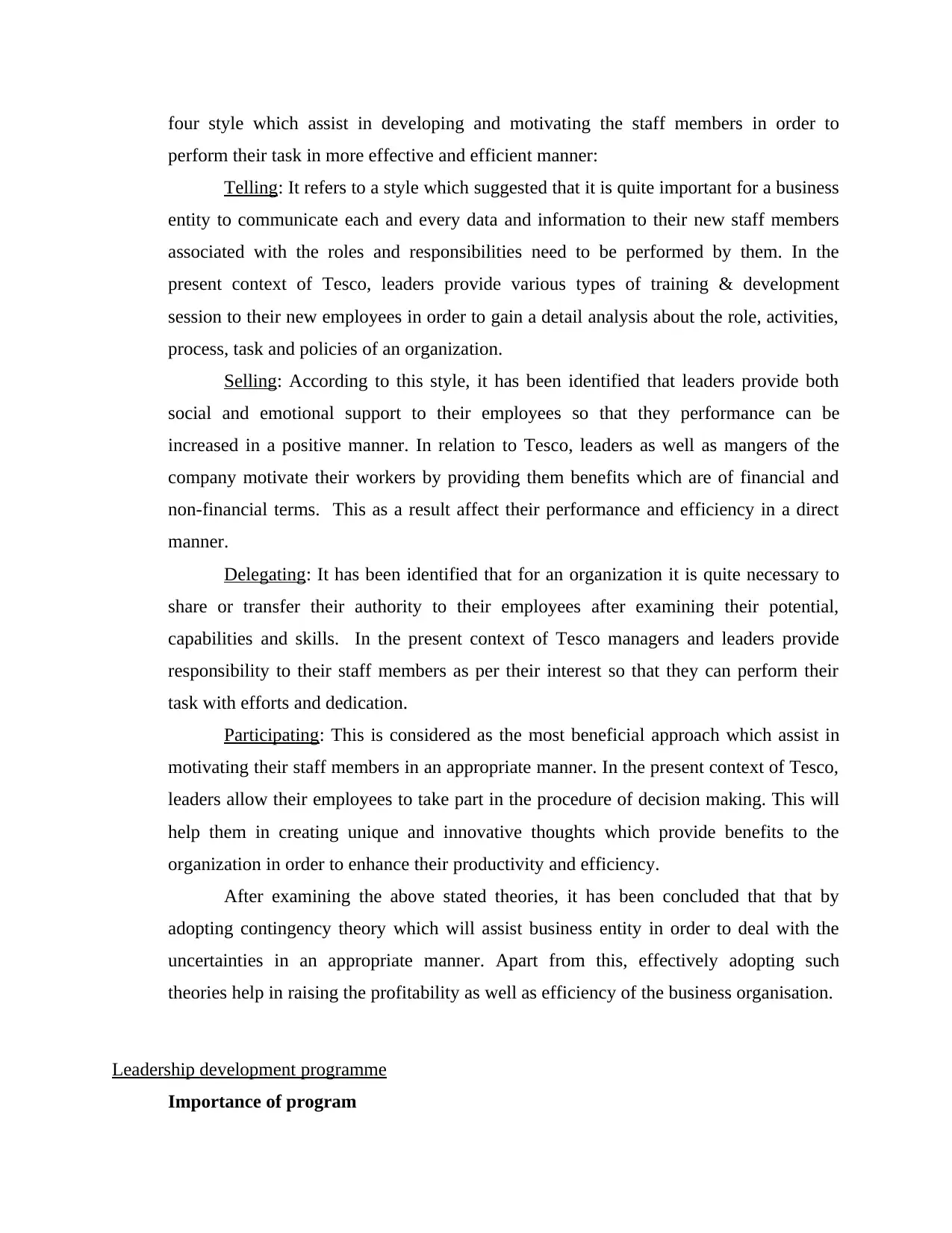
four style which assist in developing and motivating the staff members in order to
perform their task in more effective and efficient manner:
Telling: It refers to a style which suggested that it is quite important for a business
entity to communicate each and every data and information to their new staff members
associated with the roles and responsibilities need to be performed by them. In the
present context of Tesco, leaders provide various types of training & development
session to their new employees in order to gain a detail analysis about the role, activities,
process, task and policies of an organization.
Selling: According to this style, it has been identified that leaders provide both
social and emotional support to their employees so that they performance can be
increased in a positive manner. In relation to Tesco, leaders as well as mangers of the
company motivate their workers by providing them benefits which are of financial and
non-financial terms. This as a result affect their performance and efficiency in a direct
manner.
Delegating: It has been identified that for an organization it is quite necessary to
share or transfer their authority to their employees after examining their potential,
capabilities and skills. In the present context of Tesco managers and leaders provide
responsibility to their staff members as per their interest so that they can perform their
task with efforts and dedication.
Participating: This is considered as the most beneficial approach which assist in
motivating their staff members in an appropriate manner. In the present context of Tesco,
leaders allow their employees to take part in the procedure of decision making. This will
help them in creating unique and innovative thoughts which provide benefits to the
organization in order to enhance their productivity and efficiency.
After examining the above stated theories, it has been concluded that that by
adopting contingency theory which will assist business entity in order to deal with the
uncertainties in an appropriate manner. Apart from this, effectively adopting such
theories help in raising the profitability as well as efficiency of the business organisation.
Leadership development programme
Importance of program
perform their task in more effective and efficient manner:
Telling: It refers to a style which suggested that it is quite important for a business
entity to communicate each and every data and information to their new staff members
associated with the roles and responsibilities need to be performed by them. In the
present context of Tesco, leaders provide various types of training & development
session to their new employees in order to gain a detail analysis about the role, activities,
process, task and policies of an organization.
Selling: According to this style, it has been identified that leaders provide both
social and emotional support to their employees so that they performance can be
increased in a positive manner. In relation to Tesco, leaders as well as mangers of the
company motivate their workers by providing them benefits which are of financial and
non-financial terms. This as a result affect their performance and efficiency in a direct
manner.
Delegating: It has been identified that for an organization it is quite necessary to
share or transfer their authority to their employees after examining their potential,
capabilities and skills. In the present context of Tesco managers and leaders provide
responsibility to their staff members as per their interest so that they can perform their
task with efforts and dedication.
Participating: This is considered as the most beneficial approach which assist in
motivating their staff members in an appropriate manner. In the present context of Tesco,
leaders allow their employees to take part in the procedure of decision making. This will
help them in creating unique and innovative thoughts which provide benefits to the
organization in order to enhance their productivity and efficiency.
After examining the above stated theories, it has been concluded that that by
adopting contingency theory which will assist business entity in order to deal with the
uncertainties in an appropriate manner. Apart from this, effectively adopting such
theories help in raising the profitability as well as efficiency of the business organisation.
Leadership development programme
Importance of program
Paraphrase This Document
Need a fresh take? Get an instant paraphrase of this document with our AI Paraphraser
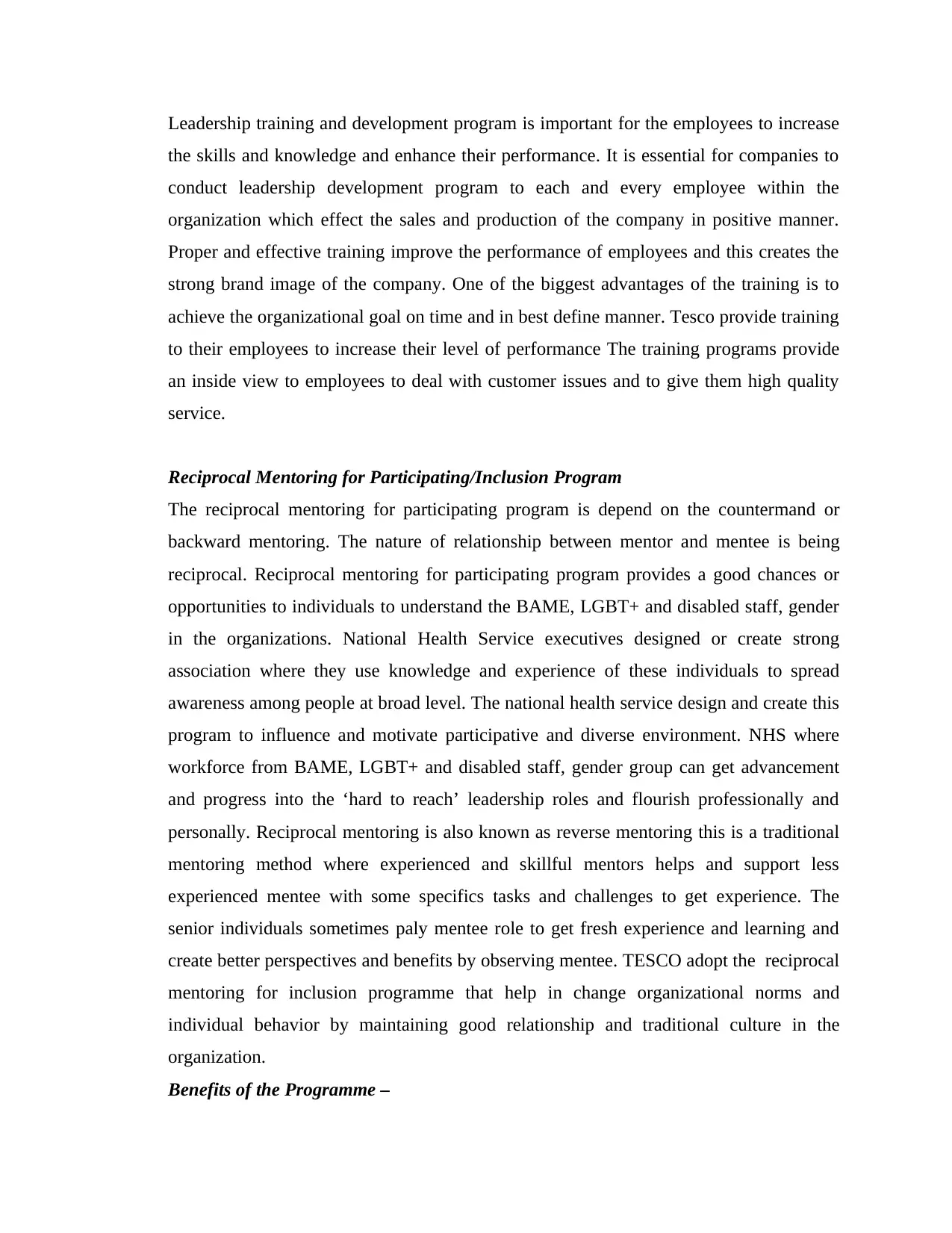
Leadership training and development program is important for the employees to increase
the skills and knowledge and enhance their performance. It is essential for companies to
conduct leadership development program to each and every employee within the
organization which effect the sales and production of the company in positive manner.
Proper and effective training improve the performance of employees and this creates the
strong brand image of the company. One of the biggest advantages of the training is to
achieve the organizational goal on time and in best define manner. Tesco provide training
to their employees to increase their level of performance The training programs provide
an inside view to employees to deal with customer issues and to give them high quality
service.
Reciprocal Mentoring for Participating/Inclusion Program
The reciprocal mentoring for participating program is depend on the countermand or
backward mentoring. The nature of relationship between mentor and mentee is being
reciprocal. Reciprocal mentoring for participating program provides a good chances or
opportunities to individuals to understand the BAME, LGBT+ and disabled staff, gender
in the organizations. National Health Service executives designed or create strong
association where they use knowledge and experience of these individuals to spread
awareness among people at broad level. The national health service design and create this
program to influence and motivate participative and diverse environment. NHS where
workforce from BAME, LGBT+ and disabled staff, gender group can get advancement
and progress into the ‘hard to reach’ leadership roles and flourish professionally and
personally. Reciprocal mentoring is also known as reverse mentoring this is a traditional
mentoring method where experienced and skillful mentors helps and support less
experienced mentee with some specifics tasks and challenges to get experience. The
senior individuals sometimes paly mentee role to get fresh experience and learning and
create better perspectives and benefits by observing mentee. TESCO adopt the reciprocal
mentoring for inclusion programme that help in change organizational norms and
individual behavior by maintaining good relationship and traditional culture in the
organization.
Benefits of the Programme –
the skills and knowledge and enhance their performance. It is essential for companies to
conduct leadership development program to each and every employee within the
organization which effect the sales and production of the company in positive manner.
Proper and effective training improve the performance of employees and this creates the
strong brand image of the company. One of the biggest advantages of the training is to
achieve the organizational goal on time and in best define manner. Tesco provide training
to their employees to increase their level of performance The training programs provide
an inside view to employees to deal with customer issues and to give them high quality
service.
Reciprocal Mentoring for Participating/Inclusion Program
The reciprocal mentoring for participating program is depend on the countermand or
backward mentoring. The nature of relationship between mentor and mentee is being
reciprocal. Reciprocal mentoring for participating program provides a good chances or
opportunities to individuals to understand the BAME, LGBT+ and disabled staff, gender
in the organizations. National Health Service executives designed or create strong
association where they use knowledge and experience of these individuals to spread
awareness among people at broad level. The national health service design and create this
program to influence and motivate participative and diverse environment. NHS where
workforce from BAME, LGBT+ and disabled staff, gender group can get advancement
and progress into the ‘hard to reach’ leadership roles and flourish professionally and
personally. Reciprocal mentoring is also known as reverse mentoring this is a traditional
mentoring method where experienced and skillful mentors helps and support less
experienced mentee with some specifics tasks and challenges to get experience. The
senior individuals sometimes paly mentee role to get fresh experience and learning and
create better perspectives and benefits by observing mentee. TESCO adopt the reciprocal
mentoring for inclusion programme that help in change organizational norms and
individual behavior by maintaining good relationship and traditional culture in the
organization.
Benefits of the Programme –
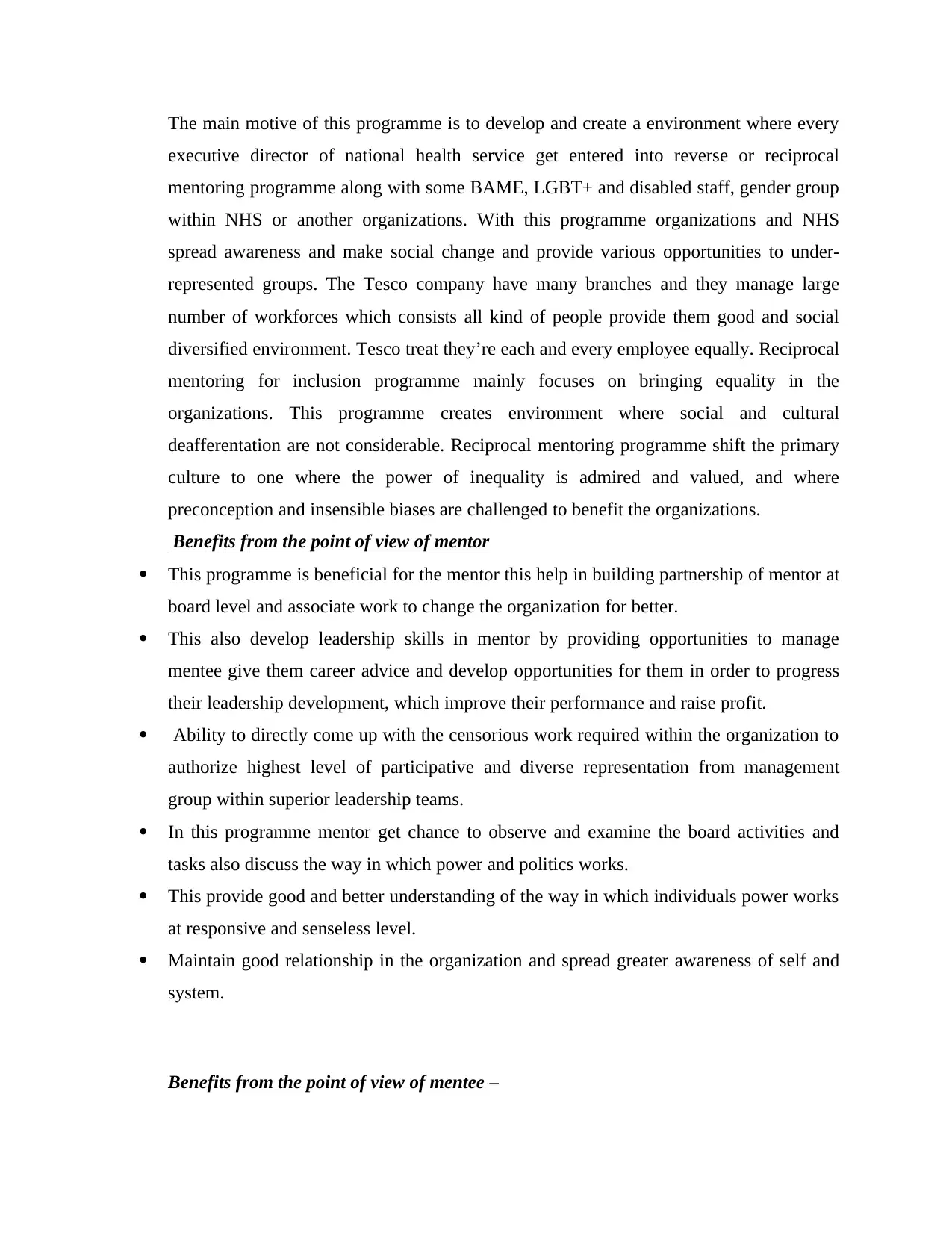
The main motive of this programme is to develop and create a environment where every
executive director of national health service get entered into reverse or reciprocal
mentoring programme along with some BAME, LGBT+ and disabled staff, gender group
within NHS or another organizations. With this programme organizations and NHS
spread awareness and make social change and provide various opportunities to under-
represented groups. The Tesco company have many branches and they manage large
number of workforces which consists all kind of people provide them good and social
diversified environment. Tesco treat they’re each and every employee equally. Reciprocal
mentoring for inclusion programme mainly focuses on bringing equality in the
organizations. This programme creates environment where social and cultural
deafferentation are not considerable. Reciprocal mentoring programme shift the primary
culture to one where the power of inequality is admired and valued, and where
preconception and insensible biases are challenged to benefit the organizations.
Benefits from the point of view of mentor
This programme is beneficial for the mentor this help in building partnership of mentor at
board level and associate work to change the organization for better.
This also develop leadership skills in mentor by providing opportunities to manage
mentee give them career advice and develop opportunities for them in order to progress
their leadership development, which improve their performance and raise profit.
Ability to directly come up with the censorious work required within the organization to
authorize highest level of participative and diverse representation from management
group within superior leadership teams.
In this programme mentor get chance to observe and examine the board activities and
tasks also discuss the way in which power and politics works.
This provide good and better understanding of the way in which individuals power works
at responsive and senseless level.
Maintain good relationship in the organization and spread greater awareness of self and
system.
Benefits from the point of view of mentee –
executive director of national health service get entered into reverse or reciprocal
mentoring programme along with some BAME, LGBT+ and disabled staff, gender group
within NHS or another organizations. With this programme organizations and NHS
spread awareness and make social change and provide various opportunities to under-
represented groups. The Tesco company have many branches and they manage large
number of workforces which consists all kind of people provide them good and social
diversified environment. Tesco treat they’re each and every employee equally. Reciprocal
mentoring for inclusion programme mainly focuses on bringing equality in the
organizations. This programme creates environment where social and cultural
deafferentation are not considerable. Reciprocal mentoring programme shift the primary
culture to one where the power of inequality is admired and valued, and where
preconception and insensible biases are challenged to benefit the organizations.
Benefits from the point of view of mentor
This programme is beneficial for the mentor this help in building partnership of mentor at
board level and associate work to change the organization for better.
This also develop leadership skills in mentor by providing opportunities to manage
mentee give them career advice and develop opportunities for them in order to progress
their leadership development, which improve their performance and raise profit.
Ability to directly come up with the censorious work required within the organization to
authorize highest level of participative and diverse representation from management
group within superior leadership teams.
In this programme mentor get chance to observe and examine the board activities and
tasks also discuss the way in which power and politics works.
This provide good and better understanding of the way in which individuals power works
at responsive and senseless level.
Maintain good relationship in the organization and spread greater awareness of self and
system.
Benefits from the point of view of mentee –
⊘ This is a preview!⊘
Do you want full access?
Subscribe today to unlock all pages.

Trusted by 1+ million students worldwide
1 out of 17
Related Documents
Your All-in-One AI-Powered Toolkit for Academic Success.
+13062052269
info@desklib.com
Available 24*7 on WhatsApp / Email
![[object Object]](/_next/static/media/star-bottom.7253800d.svg)
Unlock your academic potential
Copyright © 2020–2025 A2Z Services. All Rights Reserved. Developed and managed by ZUCOL.





